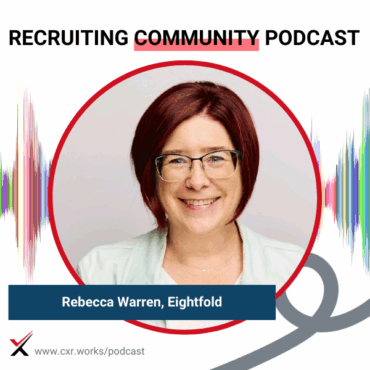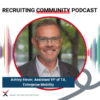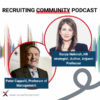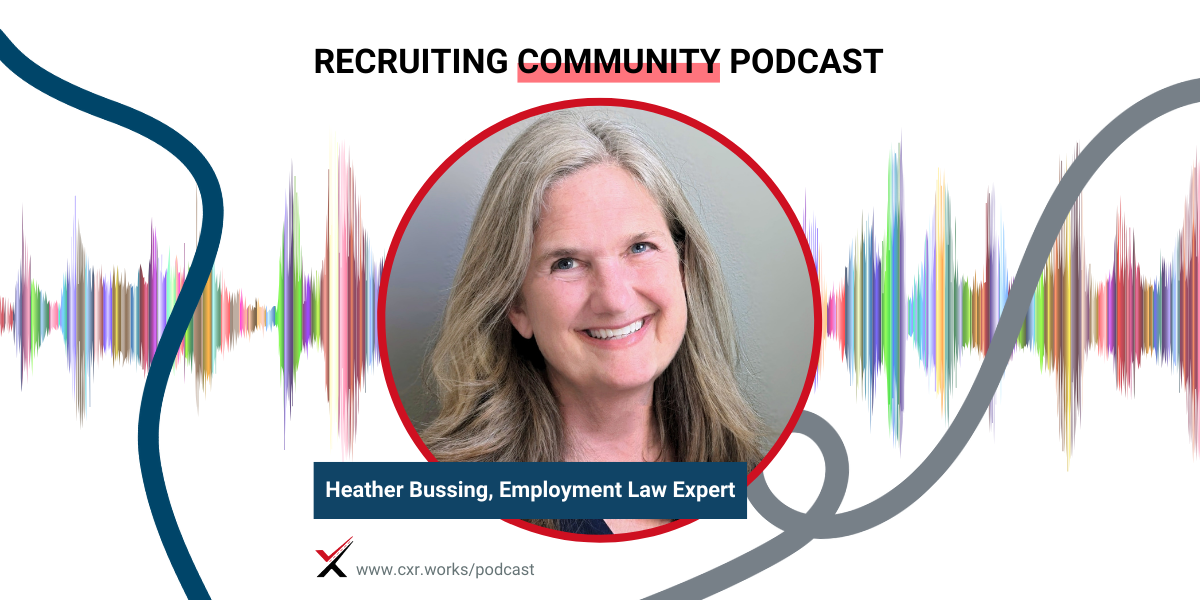
Agentic AI in Talent Acquisition: What Recruiters Need to Know and Plan For
Agentic AI is gaining traction in TA—but what does it mean for recruiters? We explore early use cases, leadership challenges, and how to avoid being left behind.
 play_arrow
play_arrow
 play_arrow
play_arrow
Transforming High-Volume Hiring at 7-Eleven Cami Grace
 play_arrow
play_arrow
From Early Childhood to Talent Tech: Allyn Bailey’s Career Crossroads Cami Grace
 play_arrow
play_arrow
In Praise of the Office Cami Grace

Featured Guests:
Heather Bussing, Employment Attorney and Former Law Professor
Hosts:
Chris Hoyt, President, CareerXroads
Gerry Crispin, Co-founder, CareerXroads
Episode Overview:
This episode explores how data and people analytics are influencing employment law, particularly around compliance, pay transparency, and equity. Heather Bussing shares insights from her decades-long legal career on how regulations like the EU Pay Transparency Directive are shifting the legal landscape from punitive actions to proactive problem-solving. The conversation addresses the intersection of HR technology, privacy, discrimination, and fairness—and how organizations can use data to drive meaningful change before issues escalate into legal challenges.
Key Topics:
The EU Pay Transparency Directive and its global implications
Shifting from litigation to prevention through data audits
Total compensation and internal equity challenges
Using data as evidence to identify and fix pay disparities
Privacy, bias, and discrimination in HR technology
Role of states vs. federal government in pay transparency enforcement
Competitive advantage through proactive compliance and fairness
Notable Quotes:
“If the data shows it, you can blame the systems, not individuals. That makes it easier to accept and fix.” – Heather Bussing
“It’s not just data—it’s evidence.” – Heather Bussing
“We’re moving forward. You’ll still need to hire people based on what they can do, not what they look like or who they love.” – Heather Bussing
“The truth is going to become expensive. Clean, reliable data will be a precious commodity.” – Heather Bussing
Takeaways:
Organizations have an opportunity to use people analytics not only for compliance but as a catalyst for fairness and competitive advantage. As laws evolve, data transparency and accuracy will be central to solving issues before they lead to litigation. Embracing this shift can position companies as leaders in equity, trust, and accountability.
Want more conversations like this?
Subscribe to the CXR podcast and explore how top talent leaders are shaping the future of recruiting. Learn more about the CareerXroads community at cxr.works.
Announcer: Welcome to the Recruiting Community Podcast, the go-to channel for talent acquisition leaders and practitioners. This show is brought to you by CXR, a trusted community of thousands connecting the best minds in the industry to explore topics like attracting, engaging, and retaining top talent. Hosted by Chris Hoyt and Gerry Crispin.
We are thrilled to have you join the conversation.
Chris Hoyt: All right, everybody. Welcome to the Recruiting Community Podcast. I’m Chris Hoyt, president of CXR. I’m with Gerry Crispin, our infamous co-founder of CareerXroads, and we are the hosts of this podcast.
We like to think we bring industry insights and updates to you in the form of a fun conversation. It’s all brought to you, of course, by the CXR CareerXroads community.
Now today, we are talking about how data and people analytics are reshaping employment law—from punitive rules to more problem-solving frameworks. With the rise of mandates like the EU’s Pay Transparency Directive, we’re seeing lawmakers move beyond the old “don’t do that” mindset to more proactive measures like pay audits or safe harbors—ideally driving real change without litigation.
So, is this a new era of compliance? One designed to fix issues before they become lawsuits?
Of course, we’ve got our guest here to walk us through her take. But first, a quick reminder: we’re streaming! We’re on YouTube, Facebook, LinkedIn, Twitch—and a couple of others. Check us out at cxr.works/podcast to catch past and future episodes. It’s an entirely new design—Jerry, I think we’re almost at 500 episodes. Good Lord!
Tons of easy ways to like, subscribe, and even let us know if you want to join the conversation.
One last thing before we introduce our guest: this is an ad-free labor of love. Nobody’s paid to be here. Nobody paid us to be on the show. We’re just happy to talk to folks we think are doing cool stuff.
So, it’s that easy. I want to welcome Heather Bussing. Heather, I don’t think we’ve had you on the show before, have we?
Heather Bussing: I don’t think so.
Chris Hoyt: That’s a miss! For those who don’t know, here’s what I know: Heather has been an employment attorney for well over 20 years—
Heather Bussing: Try almost 40.
Chris Hoyt: Forty? Really?
Heather Bussing: In 2027, it’ll be 40.
Chris Hoyt: Wow. Okay. You were also a law professor, right?
Heather Bussing: Yes.
Chris Hoyt: And you’re an advocate for telling everybody to stop and breathe once in a while.
Heather Bussing: Yes. Daily.
Chris Hoyt: Daily. Breathing is good. I think of you as the Kristen Bell to the Dax Shepard couple in our space. Poor John, right? Every time someone sees John, it’s like, “Where’s Heather?” That’s Heather’s husband.
Heather Bussing: It happens to me a lot. In college, I worked in the state legislature. My dad met the governor and introduced himself, and the governor said, “Oh, you’re Heather’s dad?” My dad was taken aback—yes.
Chris Hoyt: I think you bring a gentle gravitas to the conversation. Can you give us and the listeners an escalator pitch of who Heather is, what you stand for, and why we should care what you have to say?
Heather Bussing: About 20 years ago when I met John, I didn’t really know much about HR technology. Since then, I’ve learned a lot because we talk all the time about his work, my work, and what’s going on. I became fascinated by the intersection of employment law—which I knew well—and how technology was intersecting with and affecting work.
Technology has become a core part of how we work. Regardless of your role, we all touch tech. Package delivery drivers now take photos of deliveries—it’s everywhere.
I got interested in understanding data—why it’s needed, what makes it good or useful, how to protect it. Privacy is huge. So are issues like bias and discrimination, especially with AI. There’s good reason for concern.
It’s also hard to make effective employment laws around technology. Tech moves faster than the law, which is case-by-case. Tech is about repeatable processes. So, we have these conflicting realities. I live in both. Sometimes my brain explodes.
Chris Hoyt: I’m glad we’re here for that. Gerry, you tapped me on the shoulder and said, “Hey, have you seen what Heather’s been talking about?” What made you think she’d be a great guest?
Gerry Crispin: I can’t remember exactly what triggered it. When Heather speaks, people stop and listen—because she’s reasonable. I go to her when I see confusion, like with the Supreme Court rulings about Harvard and UNC. People misinterpret what those rulings mean.
I think the last time I approached Heather, we were ripping on DE&I—as if every recruiter is trying to hire unqualified women, and the government needs executive orders to screw it up. I get mad about this stuff. Heather says, “Be reasonable. The laws haven’t changed. We can still sue people.”
There are so many social needs—pay equity being one. Heather, do you think we’re moving forward or backward?
Heather Bussing: We’re moving forward. No matter what the federal law says, there will still be state-level laws requiring fairness and equity. You’ll still need to hire people based on what they can do, not what they look like or who they love.
We also now have data showing what’s really going on inside organizations. HR tech has trained us all to collect and analyze it. Regulators want to see it too.
If you want to solve pay equity—and it’s a great place to start—you need the data. When people see it in the data, they can’t deny discrimination exists. And if the data shows it, you can blame the systems, not individuals. That makes it easier to accept and fix.
Gerry Crispin: I’ll buy that. Over the years, we’ve pushed for transparency. Now, we’re allowed to ask about salary. Twenty or thirty years ago, doing that could get you fired.
Heather Bussing: Right. “We do not discuss such classless topics as money!”
Chris Hoyt: Heather, can you set the stage for folks who don’t know much about the EU Pay Transparency Directive? What is it and what’s driving it?
Heather Bussing: It goes into effect next June. Each EU member state is developing their own version of it.
It applies to every company with even one employee in the EU. You have to share the pay range for a role, explain typical career progression, and disclose the pay of people doing similar or comparable work—on request.
The reporting side is the exciting part. You have to do a pay equity analysis and report the results—not just the pay gap.
In the U.S., some states require pay data on the EEO-1 form, but that’s limited. The EU’s version goes further. If you find a pay gap of 5% or more, you must investigate it with employee representatives. If the gap is justified, fine. If not, you create a plan to fix it. And if you fix it, there’s no liability.
Gerry Crispin: I love that. What if we used data and law to solve the problem?
Heather Bussing: Exactly.
Gerry Crispin: And the calculation has to include total comp—benefits, not just salary.
Heather Bussing: Correct. That’s true in the U.S. too. Total comp includes everything of value the employer provides—car allowance, phone, even dry cleaning. Tech usually focuses on salary as a proxy, but it works as long as benefits are consistent among people doing comparable work.
Chris Hoyt: One big concern employers had when salary transparency came up was internal equity. New hires came in at higher salaries than people who’d been around for years. Some companies said it could take 80 years to fix that.
Do you think that concern will come up again? And what happens if companies just don’t comply?
Heather Bussing: Companies who aren’t posting pay ranges might be off the hook for now—at least federally. But at the state level? It could be a different story.
I don’t think the world will end if we know what people make. Government pay is 100% transparent. It’s a form of accountability.
Chris Hoyt: How are organizations using data and audits to uncover risk early? Are people digging in, or sticking their heads in the sand?
Heather Bussing: I think they’re looking at it because it’s competitive. You use benchmarks to see where you are in the market. But internal equity matters too.
Wage compression means long-time employees—often white men—may be paid less than newer hires. Pay equity helps protect them, too. It’s for everyone. It creates a fairer workplace and shows if you’re competitive.
Chris Hoyt: When transparency laws came out, some companies jumped in. Others skirted the law by not posting in certain markets. And some are only doing it because job boards like Indeed put wildly inaccurate estimates on their postings.
Heather Bussing: I kind of like that.
Chris Hoyt: I do too! But we’re waiting to see who gets fined first and sets the standard.
Heather Bussing: I think enforcement will ramp up at the state level. Eventually, people will realize transparency just doesn’t hurt.
Chris Hoyt: What’s the biggest challenge for employers trying to comply, stay agile, and stay competitive?
Gerry Crispin: One big challenge is aligning pay and productivity. Employers fear that total comp costs more than the output.
But we have the data now. The challenge is making sure fairness is evenly distributed. The folks doing the actual work often aren’t getting the returns. With education and data, people in the trenches can demand fairness.
Heather Bussing: Agreed. Despite AI, we still have a labor shortage. We need people, especially for roles that require critical thinking. Automation will only get you so far. People aren’t going anywhere.
Gerry Crispin: We’re already laying people off, thinking tech will replace them. Meanwhile, companies are applying for 400,000 H-1B visas. It’s a mess of our own making.
Chris Hoyt: Didn’t we just have a ruling this week about federal employees who were let go for performance but had glowing reviews? The judge reinstated them.
Heather Bussing: Yep. If you lie about why you fired someone, and it goes to court—and the judge sees the data—you lose.
Chris Hoyt: And the data was right there.
Heather Bussing: There’s data about everything now. And I used to say, “It’s not just data—it’s evidence.” Now I say, “Let’s use this data to fix things.” How cool is that?
Chris Hoyt: Do you think this “fix before litigate” model will spread globally?
Heather Bussing: Yes, I do.
Gerry Crispin: As long as we have data and access to it. There are people trying to figure out how to make data trustworthy. I believe we can solve this.
Heather Bussing: The truth is going to become expensive. Clean, reliable data will be a precious commodity.
Chris Hoyt: I love that we’re talking about this as evidence tracking. Such a smart take.
Before we let you go, we always ask our guests: If you were to write a book about this topic, what would the title be?
Heather Bussing: “Evidence for Data Nerds.” Or, “What If We Just Fix It?”
Chris Hoyt: That sounds like a campaign slogan. I’d vote for that.
Heather Bussing: Or, “It’s Not the Size of Your Data. It’s What You Do With It.”
Chris Hoyt: Love it. And who would you give the first signed copy to?
Heather Bussing: John Sumser. He’d have to live with me through it.
Chris Hoyt: That makes perfect sense. Heather, thank you so much. You’re always a joy to talk to, and we appreciate your insight and time.
Heather Bussing: I love you guys. Always happy to talk to you.
Chris Hoyt: For those listening, check out cxr.works/podcast. We’ve got a new series launching called Career Crossroads—spelled out, not the company name. Gerry, you want to give a teaser?
Gerry Crispin: I’m fascinated by how candidates make decisions throughout their careers—how they learn to make better choices over time. I’m interviewing people who’ve had a few jobs to see how that process evolves.
Chris Hoyt: Some veterans, some newbies, even some coaches. Great stuff. Can’t wait to share it.
Heather, thanks again. We’ll catch everyone next time at cxr.works/podcast.
Announcer: Thanks for listening to the Recruiting Community Podcast, where talent acquisition leaders connect, learn, and grow together. Visit cxr.works/podcast to explore past episodes, see what’s coming up next, and find out how you can join the conversation. If you’re interested in becoming a member of the CXR community, visit www.cxr.works. We’ll catch you in the next episode.
Tagged as: workplace culture, Data Privacy, AI bias, salary transparency, HR Technology, compliance.

Agentic AI is gaining traction in TA—but what does it mean for recruiters? We explore early use cases, leadership challenges, and how to avoid being left behind.
